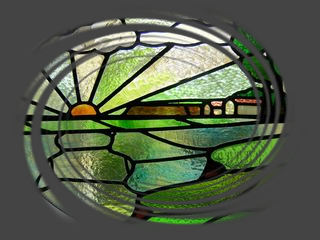 | Old Red Sandstone Information... |
The Old Red Sandstone rocks are of Devonian age in the main, but Geologists have now identified that this group of rocks range in age from the uppermost Silurian into the Lower Carboniferous.
The first series of pictures in this section are of an area north of Milford Haven and therefore the Ritec fault. This series of pictures was taken on a day led by Dr Rob Hillier an expert in the Old Red Sandstone sedimentology
Here you see the lowest part of the Old Red Sandstone where it lies above the Silurian Grey Sandstone group and in the rocks you can see the calcretes which have formed in the lower "C" horizon in the desert soils
You can also see the quartz veining in the Silurian and Devonian rocks showing the tension that these rocks have been put under
The round structures called Beaconites are trace fossils they are found abundantly and widely in the Old Red Sandstone of the British Isles, particularly in fluviatile deposits, where they occur in or closely associated with channel sandstones. Terminations to the sediment filled burrows have been almost impossible to detect, and it has hitherto been uncertain what the Beaconites organism was for sure. Lungfish or arthropods have been proposed as bring the creatures.
The series of pictures of the Townsend Tuff band from Little Castle Head show this important rock at it's best. The purple and white tuff bands are ancient volcanic ash deposits, and this one in particular is well known across the whole of the South Wales Old Red Sandstone and is therefore an important "Marker Bed" which is the geological term for a bed of rock that is easily recognised and can be seen as a specific layer in rocks of a wide area.
The next set of pictures in this section takes a tour around from Manorbier to Presipe bay on a trip led by Sid Howells one of the best geological fiend trip leaders there is. Sid is a veritable font of knowledge and rightly recognised as one of the local experts.
This area south of the Ritec fault in Pembrokeshire, South Wales, UK is one of the classic areas for studying the Old Red Sandstone geology. You don't have to study it to appreciate it though as the views are simply stunning and the beaches can be almost deserted as many are ony accessible to people who are willing to walk for a few miles and then descend sets of steps. All this gives the place a wonderfully wild beauty.
This area is covered by the British Geological Survey map of Pembroke and Linney Head,
Rhiw-y-fan Gully exposes approximately 150 m of the Lochkovian aged, uppermost St. Maughans Formation (Hawley and Owen, 2008). The latter is mudstone-dominated, comprising flat laminated to massive red mud- and siltstones with well-developed pedogenic features including isolated calcrete nodules, amalgamated nodule beds and wedge-shaped peds. We wre taken here to see these features by one of the Authors, but it was a terrible day weather wise so not a lot of pictures. You can see Beaconites burrows again here shwoing the rocks are the same age as those seen in Pembrokeshire
Both of these trips were organised by the South Wales Geologists Association
If you want to see more picture of Old Red Sandstone in South Wales you can see more on the Pen-y-Fan & Corn Ddu gallery on this site. The main peaks of all of these hills in the northern Brecon Beacons are the same Old Red Sandstone rocks
These pictures were taken on the Olympus E-30 and E-510 cameras using a series of lenses (mainly the excellent 11-22mm lens on the E-30)